CURRENT LITERATURE.
The Spanish War of 1585-1587. Vol. XL of the Naval Records Society. Edited by Julian S. Corbet, L.L.M. (Published by the "Navy Records Society.") — Speaking generally, the present volume may be regarded as introductory to the two volumes edited for the Society by Professor Laughton, dealing with "The Defeat of the Spanish Armada." The same lines have been followed in arrangement and method, and the three together form a continuous picture of the opening years of our first great naval war, and the weapons with which it was fought. The documents collected in this volume fall naturally into two groups : (1) "The Indies Voyage" of 1585, when Drake captured San Domingo, Carthagena, and Panama; and (2) " The Cadiz Voyage.' The information regarding the former is rather meagre from the time Drake left the Spanish coast, but enough remains to enable us to understand the extraordinary impression the expedition made in Europe at a time when a universal Spanish domination seemed inevitable. Part II., " The Cadiz Voyage," is perhaps of more general interest to us at the present time. To this day it may serve as the finest example of how a small well-handled fleet, carrying a compact landing force, and acting on a nicely timed offensive, may paralyse the mobilisation of an overwhelming host. Drake, by securing a central position at St. Vincent, midway between Cadiz and Lisbon, the chief ports at which the Armada was being fitted out, was able to act on interior lines, and the mere shifting of his position now and again was sufficient to throw the whole system of his enemy into a tangled confusion. The appendix contains many interesting details relating to Admiralty administration, mobilisation arrangements, and naval ordnance, the account of the ordnance being extremely interesting. The fact that in those days ships carried a Primary and Secondary Armament corresponding very closely to the system of our own time may be news to some of our readers. The Primary Armament consisted of muzzle-loading guns, but the guns comprising the Secondary Armament were breech-loaders, and were mounted upon the superstructure and tops exactly as they are in the most modern of battleships. Furthermore, the breech- loaders were provided with moveable powder chambers corre- sponding to the modern cartridge case, and as they wore mounted on some non-recoil system, and did not require relaying after each discharge, they differed hardly at all either in conception or practice from the modern quick-firer or machine-gun of to-day.


















































 Previous page
Previous page